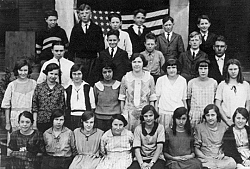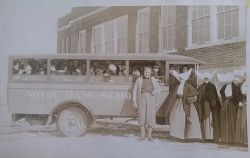Daughters of Charity of Saint Vincent de Paul's history at Catholic Grammar School

Michael Courtney
Diocese of Salt Lake City Archivist
SALT LAKE CITY — On Sept. 7, 1920, the Daughters of Charity of Saint Vincent de Paul began their first ministry in the state of Utah by welcoming 210 students to the newly opened Catholic Grammar School, located at the former Judge-Mercy Memorial Hospital. As teachers, the Daughters of Charity focused on the academic, spiritual, cultural and physical development of their pupils, leaving a lasting impression on all those who passed through the school’s halls. The Daughters of Charity would remain in Salt Lake City for a short seven years, until the Catholic Grammar School merged with Catholic Grammar School Number Two, becoming the Judge Memorial Grammar and High School. The Sisters of the Holy Cross took over the administration of Judge Memorial Grammar and High School because the rule of the Daughters of Charity at that time prohibited them from teaching boys over the age of 12.
At the request of the Most Rev. John J. Mitty, third Bishop of Salt Lake, the Daughters went to teach at the newly opened Notre Dame de Lourdes School in Price.
As educators in Salt Lake City, the Daughters of Charity employed the most current pedagogy in all the subjects they taught. In penmanship, the sisters used the Palmer Method. As a Palmer Method school, Catholic Grammar School occasionally was visited by representatives from the A.N. Palmer Company, who would check on the progress of students’ penmanship, encouraging the Daughters to submit pupils with the best penmanship to the company so they could win Palmer Method rewards.
Just as the Daughters offered their schoolchildren the best academic training, they likewise offered them the very best instruction in religious education. The Daughters of Charity asked a diocesan priest, the Rev. Louis J. Fries, to give their students weekly instruction on Christian doctrine. Fr. Fries took to this task with gusto. He often held contests with prizes to motivate students. One year, near Christmas, Fr. Fries announced a writing competition for the fifth and sixth grades. He asked interested students to write an essay on Christmas; the winning papers, one from each class, would be published in the Diocesan periodical the Catholic Monthly.
In addition to rigorous academics and religious preparation, the sisters brought culture to their charges through music and theater. One of the first hires the Daughters of Charity made was a music teacher: Gertrude Tremblay. Tremblay taught vocal, instrumental theory and solfeggio classes, led the schools’ choir and even established a music studio, which included a Victrola record player. According to one observer, the Victrola, “put vim into the ranks as they march to and from the class rooms, and will be an aid in cultivating the taste of all that is noble and elevating in the music by the beautiful selections which will be rendered for the pupils from time to time.”
Theater, too, was an important element at the Catholic Grammar School. The students participated in plays. At the end of the school year, the Daughters organized an annual variety show at the Salt Lake Theater that highlighted student talent in every grade level.
The Daughters of Charity equally concerned themselves with the physical wellbeing of their students. For the students’ physical wellness, the sisters appointed two military veterans to give drill instruction to the boys. For the girls, the sisters retained a laywoman to instruct them in physical culture. Furthermore, the Daughters encouraged sports. One of the most popular sports played by both boys and girls was basketball. For the students’ health, the Daughters employed a school nurse, who gave weekly lectures on hygiene and physiology, visited the homes of sick children and gave regular checkups to the schoolchildren. For the students’ nutrition, the Daughters made provisions for drinks, soups and sandwiches for pupils who did not bring their lunches from home.
In this educational milieu created by the Daughters of Charity, a son of a pharmacist and future priest, Jerome Stoffel, grew and learned.
Msgr. Stoffel, born June 1, 1910, to Charles and Marianne Stoffel, was one of the 210 students the Daughters of Charity greeted on that first day of school in 1920. In an 1989 interview, Msgr. Stoffel said the Daughters of Charity “were giants.”
The Daughters expected all their students to work hard. Msgr. Stoffel worked hard in school, indeed. In 1924, he won an A.N. Palmer Method certificate for penmanship. He also participated in Fr. Louis Fries’ contests. While Msgr. Stoffel was in seventh grade, Fr. Fries offered a cash prize to one pupil from each grade who gave the best answers to his questions on doctrine. One of six seventh-graders who entered Fries’ challenge. Msgr. Stoffel lost the contest to his classmate Margaret O’Connor.
In 1924, Msgr. Stoffel graduated from the Catholic Grammar School and continued on to Catholic High School, where he graduated in 1928. He then studied at Gonzaga University for two years and entered St. Patrick’s Seminary, Menlo Park in 1930. On June 6, 1936, Bishop James Kearney ordained him to the priesthood.
During his priestly ministry in the Diocese of Salt Lake City, Msgr. Stoffel served as a pastor, chaplain, administrator, historian and archivist. He died on May 13, 2001.
The Daughters of Charity of St. Vincent de Paul laid a strong educational foundation for their students at the Catholic Grammar School. From this foundation, graduates such as Msgr. Jerome Stoffel built holy and successful lives.
© Copyright 2024 The Diocese of Salt Lake City. All rights reserved.



Stay Connected With Us